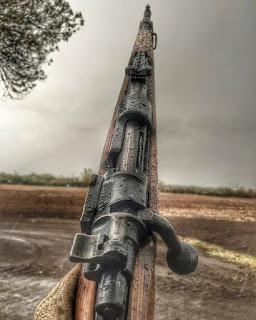Karabiner 98 Aka Kar 98
https://specialmilitaryforces.blogspot.com/2020/05/the-karabiner-98-kurz-german-kaabin.html
The Karabiner 98 kurz (German: [kaʁaˈbiːnɐ ˌʔaxtʔʊntˈnɔʏntsɪç ˈkʊɐ̯ts]; "carbine 98 short", often abbreviated Kar98k or K98k and often incorrectly referred to as a “K98” (which was a Polish Carbine) is a bolt-action rifle chambered for the 7.92×57mm Mauser cartridge that was adopted on 21 June 1935 as the standard service rifle by the German Wehrmacht.It was one of the final developments in the long line of Mauser military rifles. Although supplemented by semi- and fully automatic rifles during World War II, it remained the primary German service rifle until the end of the war in 1945. Millions were captured by the Soviets at the conclusion of World War II and were widely distributed as military aid. The Karabiner 98k therefore continues to appear in conflicts across the world as they are taken out of storage during times of strife.
VARIANTS:-
Kriegsmodell
Starting in late 1944, Karabiner 98k production began transition to the Kriegsmodell ("war model") variant. This version was simplified to increase the rate of production, removing the bayonet lug, cleaning rod, stock disc (which functions as a bolt disassembly tool), and other features deemed to be unnecessary. Non-critical parts like the stock were finished to lower standards and metal parts like the nose cap, barrel band, floor plate and trigger guard (lacking the small locking screw provision) had become simplified stamped parts that were less elaborately mounted to the rifle. The M98 bolt was also simplified by stopping milling the two oval-shaped emergency gas relief holes in the bottom of the bolt. Instead two emergency gas relief holes were drilled and the bolt guide was omitted from the bolt body. It had less serial numbered parts, a phosphate metal surface finish, and a hole at the bottom end of the butt plate that replaced the stock disk. At least two transitional variants existed, which incorporated only some Kriegsmodell features, and some factories never switched to Kriegsmodell production at all.
Sniper variant
For snipers, Karabiner 98k rifles selected for being exceptionally accurate during factory tests were fitted with a telescopic sight as sniper rifles. Karabiner 98k sniper rifles had an effective range of up to 1,000 m (1,094 yd) when used by a skilled sniper. The German Zeiss Zielvier 4× (ZF39) telescopic sight had bullet drop compensation in 50 m (55 yd) increments for ranges from 100 to 800 m (109 to 875 yd) or in some variations from 100 to 1,000 m (109 to 1,094 yd). There were ZF42 4×, Zeiss Zielsechs 6× and Zielacht 8× telescopic sights by various manufacturers like the Ajack 4× and 6×, Hensoldt Dialytan 4×, Kahles Heliavier 4× and Opticotechna Dialytan 4× with similar features employed on Karabiner 98k sniper rifles. Several different mountings produced by various manufacturers were used. The Karabiner 98k was not designed to accept telescopic sights. Attaching such sights to a Karabiner 98k required machining by a skilled armourer. A telescopic sight mounted low above the center axis of the receiver will not leave enough space between the rifle and the telescopic sight body for unimpaired operation of the bolt handle or the three-position safety catch lever. This ergonomic problem was solved by mounting the telescopic sight relatively high above the receiver and sometimes modifying or replacing the safety operating lever or using an offset mounting to position the telescopic sight axis to the left side in relation to the receiver center axis. A common minor modification was replacing the stock buttplate with a waffled anti-slip "sniper" buttplate. Approximately 132,000 of these sniper rifles were produced by Germany.
Paratrooper variants
Experimental versions of the Karabiner 98k intended for the German paratroopers that could be transported in shortened modes were produced. The standard Karabiner 98k was too long to be carried in a parachute drop. However, the German paratroopers made only limited combat drops after the 1941 Battle of Crete; there was therefore little need for these rifles. Specimens with folding stocks (Klappschaft) and with detachable barrels (Abnehmbarer Lauf) are known to have been produced at Mauser Oberndorf.
G40k
The G40k with a total length of 1,000 mm (39.37 in) and a barrel length of 490 mm (19.29 in) and 3.2 kg (7.1 lb) weight was a shortened experimental version of the Karabiner 98k.The rear tangent sight of the G40k was graduated for s.S. Patrone cartridges from 100 m to 1000 m in 100 m increments. A batch of 82 G40k rifles was produced in 1941 at Mauser Oberndorf.
Mauser KKW cadet rifle
The Mauser KKW cadet rifle is a single shot, .22 caliber rifle that was introduced in 1938. It is virtually identical to the Karabiner 98k. These cadet rifles were used by all German military, paramilitary and police organizations, especially the Hitler Youth.










